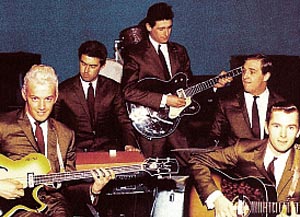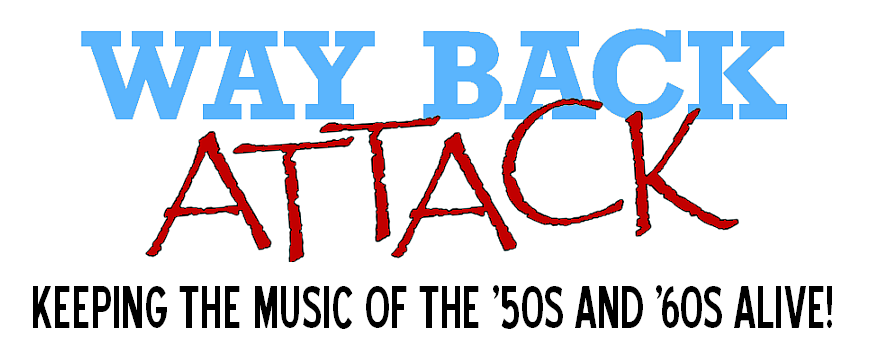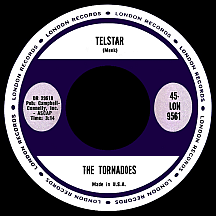THE TORNADOES
Telstar
The mad genius of producer-freak Joe Meek reached its zenith in 1962. Attempts to make a musical impact within the confines of his modest London flat came together to ignite a worldwide phenomenon. Most of the credit at the time went to a band he'd assembled called The Tornados, but to Meek that was inconsequential; the galaxy-spanning sound of "Telstar" was constructed inside his head and became the most successful of his many innovative recordings.
While growing up in the 1930s, the Gloucestershire lad developed a fascination with electronics, spending most of his free time tinkering with radios, record players, speakers and the like, wiring them in different ways to get unusual sounds. After a late-'40s tour of duty with the Royal Air Force, he resumed his experiments with sound, overdubbing and editing, frequently going overboard with reverb, not unlike the experiments going on at the time in Les Paul's garage thousands of miles away in Los Angeles. By the mid-'50s, Joe was working as a studio engineer for the International Broadcasting Company in London, later manning the board during sessions for Lonnie Donegan, Petula Clark and others. Around 1957 he left IBC and soon began producing records at Lansdowne Studios, which he helped design, located in London's Holland Park area. He would eventually ply his cockeyed craft in the home studio he'd rigged up at the aforementioned low-rent flat. In 1958, "Put a Ring on My Finger," which he'd written under the pseudonym Robert Duke, was a hit in America for, coincidentally, Les Paul and Mary Ford, opening him to the possibilities that existed beyond the U.K. But first he had to stake his claim at home.
Joe left Lansdowne and started his own small label, Triumph, in early 1960, promptly scoring a top ten hit a few months later with Michael Cox's recording of "Angela Jones" (written by North Carolina-born singer-songwriter John D. Loudermilk), a conventional teen ballad containing nary a hint of the madness to come. Triumph Records was short-lived but Meek made further maneuvers, scoring other U.K. hits including John Leyton's "Johnny Remember Me," an overdramatic sonic painting replete with echo-drenched backing vocals and a galloping rhythm; released on Top Rank, it hit number one in the fall of 1961.
Not long afterwards, he ran an ad in Melody Maker seeking musicians. Alan Caddy and Clem Cattini, former members of Johnny Kidd and the Pirates (best known for "Shakin' All Over," a number one U.K. hit in August 1960), answered and were hired as session players. He teamed them with three other musicians, christened the quintet The Tornados (spelled Tornadoes in some countries including the U.S.), and set them up backing Billy Fury, one of Britain's top acts of the early '60s. Within months the group, separate from Fury, served as a potential threat to The Shadows, Britain's dominant instrumental band (apart from their own backup duties for Cliff Richard) the previous two years. Norman Hale was the original keyboard player for the Tornadoes, featured on the band's debut single "Love and Fury" (its title a subtle reference to their "day job"). Hale left after this one recording, his replacement was Roger Lavern, and the lineup was set: guitarists Caddy and George Bellamy, drummer Cattini, keyboard player Lavern and German-born bassist Heinz Burt, all between the ages of 20 and 23 at the moment of inception.
Meek's cosmic masterpiece formed in his mind the following July when NASA launched the satellite Telstar, realizing the goal of transmitting images and sounds through space, demonstrated immediately on television screens the world over. His objective was to create a majestic theme song for the space age invention that would (and did) establish a new standard for communication in the coming years. "Telstar" was recorded in two days...at least the Tornadoes' part was! After they left, Meek brought in Geoff Goddard, who played the clavioline (an early forerunner to the synthesizer), a portable, battery-operated keyboard that Joe felt had an "otherworldly" sound; Goddard also supplied the 'aaah-aaah-aaah' vocal part near the end of the song. Rocket launch effects (rumored to be a toilet flush played backwards) sandwiched Meek's musical delusion-come-to-life. When the Tornadoes heard the finished master, they had mixed, mostly negative, reactions (though it couldn't have been that jarring, as the first single had given a hint as to the direction the producer was taking). No one but Meek felt the song stood a chance of making it anyway, this distorted mess that would surely be rejected by radio programmers and the almighty BBC. Music reviewers were brutal in their assessment, supporting the band's initial reactions.

But radio airplay came immediately after the single's U.K. release in August '62 and it went on to spend the entire month of October at number one. It hit in several countries like an atomic chain reaction, breaking onto the U.S. charts (a feat the Shadows never managed) the first week in November, reaching number one by Christmas and remaining on top into early '63, its success predating the surge of British acts that invaded America by more than a year. Hundreds of cover versions appeared (one of the oddest a version by Bobby Rydell with added lyrics); Meek's bank account would have been busting at the seams had it not been for a lawsuit filed by the copyright owners of the theme from a French film, The Battle of Austerlitz, which Joe claimed he had never heard of. The case dragged on for several years, hinging on a coincidental similarity between the first seven notes of each tune; it finally ended in Meek's favor...but by that time he was dead. On February 3, 1967, the 37-year-old shot and killed his landlady during an argument, then turned the gun on himself, a bizarre murder-suicide possibly brought on by drug use, debt, lawsuits, confusion over his sexual orientation and an increasing paranoia. The exact reasons why are still anyone's guess.
After "Telstar" topped the American charts a projected tour was sidelined, owing perhaps to the band's commitment to Billy Fury (they parted ways with the singer later in '63). There was also the matter of those other Tornadoes from Redlands, California, together since 1959, irked over being cut off at the pass by their higher-profile Brit counterparts (the fabulous "Bustin' Surfboards" had already been making inroads at radio, including a top ten breakthrough in Los Angeles, when "Telstar" broke in America). The surf group reluctantly changed its name to The Hollywood Tornadoes to avoid confusion with the chart-topping British usurpers.
The U.K. Tornadoes went top ten with another Meek composition, the similar but more poppish "Globe Trotter" (London Records in the U.S. chose to pursue the flip side, "Like Locomotion," getting a less-than-stellar reception). The third British single, "Robot," hit the top 20 in the spring while "Ridin' the Wind," a stronger, rockin' track, landed in the lower regions of the American charts. The "Telstar" sound was evident on every release, becoming a little more tiring with each. "The Ice Cream Man" and "Dragonfly" hit the U.K. top 50; by October of '63 they were off the charts for good. Heinz Burt (an object of Joe's erotic fantasies) had already left the band and begun hitting the charts as a vocalist using his first name, Heinz ("Just Like Eddie" was a top ten hit that summer).
Joe Meek moved on, finding success in what turned out to be his final few years; "Have I the Right?" by The Honeycombs was his greatest post-Tornadoes hit. The group, meanwhile, came apart at the seams. Members gradually drifted away, new musicians coming in to replace them, drummer Cattini the last to go in 1965. By that time they had left Decca and signed with EMI's Columbia Records. The completely realigned group continued for a couple of years before breaking up. The original members (minus Caddy) reunited in 1975 as The Original Tornados; a new version of "Telstar" was recorded but few noticed or cared. The ballistic 1962 original remains a unique and extraordinary piece of music history.


